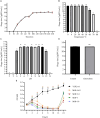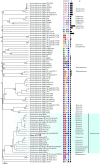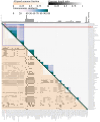Characterization and genomic analysis of a lytic Stenotrophomonas maltophilia short-tailed phage A1432 revealed a new genus of the family Mesyanzhinovviridae
- PMID: 38993489
- PMCID: PMC11236537
- DOI: 10.3389/fmicb.2024.1400700
Characterization and genomic analysis of a lytic Stenotrophomonas maltophilia short-tailed phage A1432 revealed a new genus of the family Mesyanzhinovviridae
Abstract
Stenotrophomonas maltophilia (S. maltophilia) is an emerging opportunistic pathogen that exhibits resistant to a majority of commonly used antibiotics. Phages have the potential to serve as an alternative treatment for S. maltophilia infections. In this study, a lytic phage, A1432, infecting S. maltophilia YCR3A-1, was isolated and characterized from a karst cave. Transmission electron microscopy revealed that phage A1432 possesses an icosahedral head and a shorter tail. Phage A1432 demonstrated a narrow host range, with an optimal multiplicity of infection of 0.1. The one-step growth curve indicated a latent time of 10 min, a lysis period of 90 min, a burst size of 43.2 plaque-forming units per cell. In vitro bacteriolytic activity test showed that phage A1432 was capable to inhibit the growth of S. maltophilia YCR3A-1 in an MOI-dependent manner after 2 h of co-culture. BLASTn analysis showed that phage A1432 genome shares the highest similarity (81.46%) with Xanthomonas phage Xoo-sp2 in the NCBI database, while the query coverage was only 37%. The phage contains double-stranded DNA with a genome length of 61,660 bp and a GC content of 61.92%. It is predicted to have 79 open reading frames and one tRNA, with no virulence or antibiotic resistance genes. Phylogenetic analysis using terminase large subunit and DNA polymerase indicated that phage A1432 clustered with members of the Bradleyvirinae subfamily but diverged into a distinct branch. Further phylogenetic comparison analysis using Average Nucleotide Identity, proteomic phylogenetic analysis, genomic network analysis confirmed that phage A1432 belongs to a novel genus within the Bradleyvirinae subfamily, Mesyanzhinovviridae family. Additionally, phylogenetic analysis of the so far isolated S. maltophilia phages revealed significant genetic diversity among these phages. The results of this research will contribute valuable information for further studies on their morphological and genetic diversity, will aid in elucidating the evolutionary mechanisms that give rise to them.
Keywords: Bradleyvirinae; Mesyanzhinovviridae; Stenotrophomonas maltophilia; karst cave; lytic phage; new genus; phage.
Copyright © 2024 Li, Xu, Yang, Yang, Wu, Li, Yang, Fang, Wu, Tan, Xiao and Weng.
Conflict of interest statement
The authors declare that the research was conducted in the absence of any commercial or financial relationships that could be construed as a potential conflict of interest.
Figures








Similar articles
-
Characterization of the novel cross-genus phage vB_SmaS_QH3 and evaluation of its antibacterial efficacy against Stenotrophomonas maltophilia.Front Microbiol. 2025 Apr 11;16:1570665. doi: 10.3389/fmicb.2025.1570665. eCollection 2025. Front Microbiol. 2025. PMID: 40291807 Free PMC article.
-
Biochemical and genomic characterization of a novel bacteriophage BUCT555 lysing Stenotrophomonas maltophilia.Virus Res. 2021 Aug;301:198465. doi: 10.1016/j.virusres.2021.198465. Epub 2021 May 28. Virus Res. 2021. PMID: 34052250
-
Potential application of a newly isolated phage BUCT609 infecting Stenotrophomonas maltophilia.Front Microbiol. 2022 Nov 21;13:1001237. doi: 10.3389/fmicb.2022.1001237. eCollection 2022. Front Microbiol. 2022. PMID: 36478859 Free PMC article.
-
Biological characteristics and genomic analysis of a Stenotrophomonas maltophilia phage vB_SmaS_BUCT548.Virus Genes. 2021 Apr;57(2):205-216. doi: 10.1007/s11262-020-01818-5. Epub 2021 Jan 20. Virus Genes. 2021. PMID: 33471272
-
The Potential of Phage Therapy against the Emerging Opportunistic Pathogen Stenotrophomonas maltophilia.Viruses. 2021 Jun 3;13(6):1057. doi: 10.3390/v13061057. Viruses. 2021. PMID: 34204897 Free PMC article. Review.
Cited by
-
Pseudomonas Phage Lydia and the Evolution of the Mesyanzhinovviridae Family.Viruses. 2025 Mar 4;17(3):369. doi: 10.3390/v17030369. Viruses. 2025. PMID: 40143297 Free PMC article.
-
Characterization of the novel cross-genus phage vB_SmaS_QH3 and evaluation of its antibacterial efficacy against Stenotrophomonas maltophilia.Front Microbiol. 2025 Apr 11;16:1570665. doi: 10.3389/fmicb.2025.1570665. eCollection 2025. Front Microbiol. 2025. PMID: 40291807 Free PMC article.
-
Enhanced suppression of Stenotrophomonas maltophilia by a three-phage cocktail: genomic insights and kinetic profiling.Antimicrob Agents Chemother. 2025 Mar 5;69(3):e0116224. doi: 10.1128/aac.01162-24. Epub 2025 Jan 22. Antimicrob Agents Chemother. 2025. PMID: 39840957 Free PMC article.
-
Characterization and antimicrobial activity of a novel lytic phage vB_SmaS_QH16 against Stenotrophomonas maltophilia: in vitro, in vivo, and biofilm studies.Front Cell Infect Microbiol. 2025 Jul 10;15:1610857. doi: 10.3389/fcimb.2025.1610857. eCollection 2025. Front Cell Infect Microbiol. 2025. PMID: 40708751 Free PMC article.
References
-
- Aiewsakun P., Adriaenssens E. M., Lavigne R., Kropinski A. M., Simmonds P. (2018). Evaluation of the genomic diversity of viruses infecting bacteria, archaea and eukaryotes using a common bioinformatic platform: steps towards a unified taxonomy. J. Gen. Virol. 99, 1331–1343. doi: 10.1099/jgv.0.001110, PMID: - DOI - PMC - PubMed
-
- Alcock B. P., Huynh W., Chalil R., Smith K. W., Raphenya A. R., Wlodarski M. A., et al. (2023). CARD 2023: expanded curation, support for machine learning, resistome prediction at the comprehensive antibiotic resistance database. Nucleic Acids Res. 51, D690–d699. doi: 10.1093/nar/gkac920, PMID: - DOI - PMC - PubMed
LinkOut - more resources
Full Text Sources
Miscellaneous

